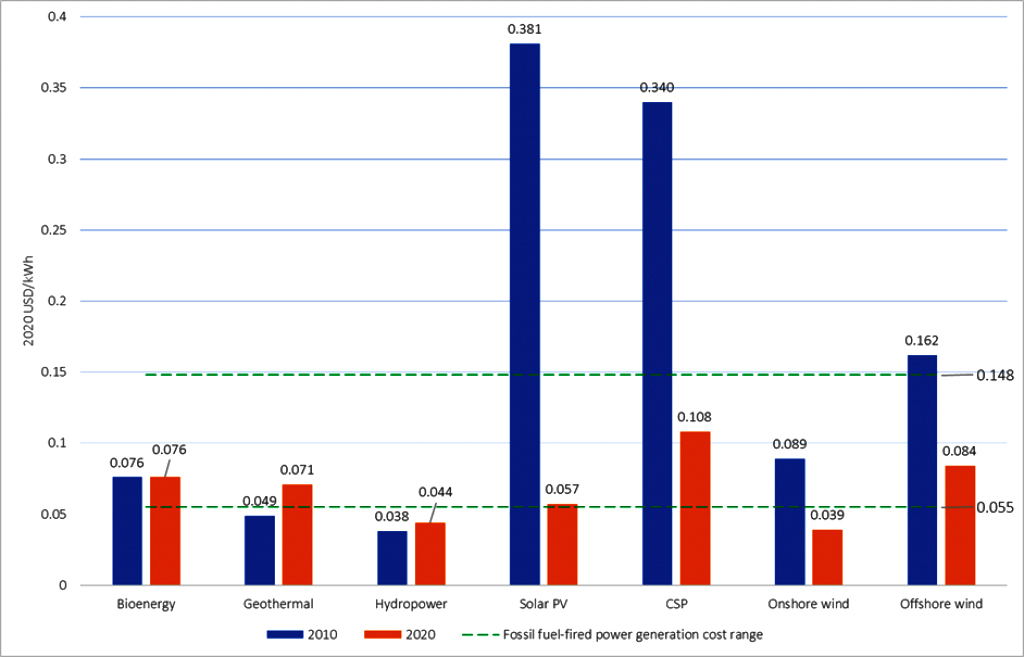Indian Economy
Renewable Power Generation Costs in 2020: IRENA
- 25 Jun 2021
- 4 min read
Why in News
Recently, the International Renewable Energy Agency (IRENA) released the ‘Renewable Power Generation Costs in 2020’ report.
Levelized cost of electricity trends by technology, 2010 and 2020
Key Points
- Replacing Coal with Renewables:
- 810 gigawatts (GW) capacity of the world’s existing coal-fired plants i.e. 38% of the total global energy capacity now have higher operating costs than new utility-scale photovoltaics and onshore wind energy.
- The cost range for generation of fossil fuel-fired power in G20 countries is estimated to be between USD 0.055 per kilowatt-hour (kWh) and USD 0.148/kWh.
- Replacing this expensive coal power with renewables will save operators USD 32 billion a year and reduce annual carbon dioxide emissions by around three billion tonnes.
- Renewable capacities added in 2019 would have saved emerging and developing nations USD 6 billion per annum compared to the same capabilities from conventional sources.
- 810 gigawatts (GW) capacity of the world’s existing coal-fired plants i.e. 38% of the total global energy capacity now have higher operating costs than new utility-scale photovoltaics and onshore wind energy.
- Growth of Renewables in 2020:
- The year 2020 was a record year for renewables deployment despite the Covid-19- pandemic, with 261 GW installed. The addition was almost 50% higher than that made in 2019 and represented 82% of the global new power capacity.
- Around 162 GW or 62% of total renewable power capacity added last year had lower costs than the cheapest new fossil fuel option.
- Supplies from Sources Added in 2020:
- Geothermal > Photovoltaics (PV)> Wind power> Hydropower > Bioenergy> Concentrating solar power.
- Reasons for Growth:
- Between 2000 and 2020, renewables capacity grew more than three times, increasing by 754 GW to 2,799 GW.
- The growth was occasioned by advancements in technologies, consistent fall in component costs, cost-competitive supply distribution channels, learning by using and commercial-scale availability.
- Reducing Cost of Renewables:
- In about 10 years (2010-2020), the cost of power produced from commercial solar PVs fell by 85%, CSP 68%, onshore wind 68% and offshore wind 48%.
- The outlook till 2022 sees global renewable power costs falling further.
- In about 10 years (2010-2020), the cost of power produced from commercial solar PVs fell by 85%, CSP 68%, onshore wind 68% and offshore wind 48%.
- Indian Initiatives for Renewable Energy:
International Renewable Energy Agency
- About:
- It is an intergovernmental organisation, it was officially founded in Bonn, Germany, in January 2009.
- Currently it has 164 members, India is the 77th Founding Member of IRENA.
- It has its headquarters in Abu Dhabi, United Arab Emirates.
- Major Functions:
- It supports countries in their transition to a sustainable energy future, and serves as the principal platform for international cooperation, a centre of excellence, and a repository of policy, technology, resource and financial knowledge on renewable energy.
- It promotes the widespread adoption and sustainable use of all forms of renewable energy, including bioenergy, geothermal, hydropower, ocean, solar and wind energy in the pursuit of sustainable development, energy access, energy security and low-carbon economic growth and prosperity.
Way Forward
- Renewables in all intent and purposes are the most affordable energy sources. Countries should consider deploying these at scale to achieve the Paris Agreement targets and shield their economies from external shocks from fossil fuel markets.
- Right policy incentives and financial incentives to de-risk the sector as well as political support is the need of the hour as most countries have already signaled their commitments towards deploying renewables.





